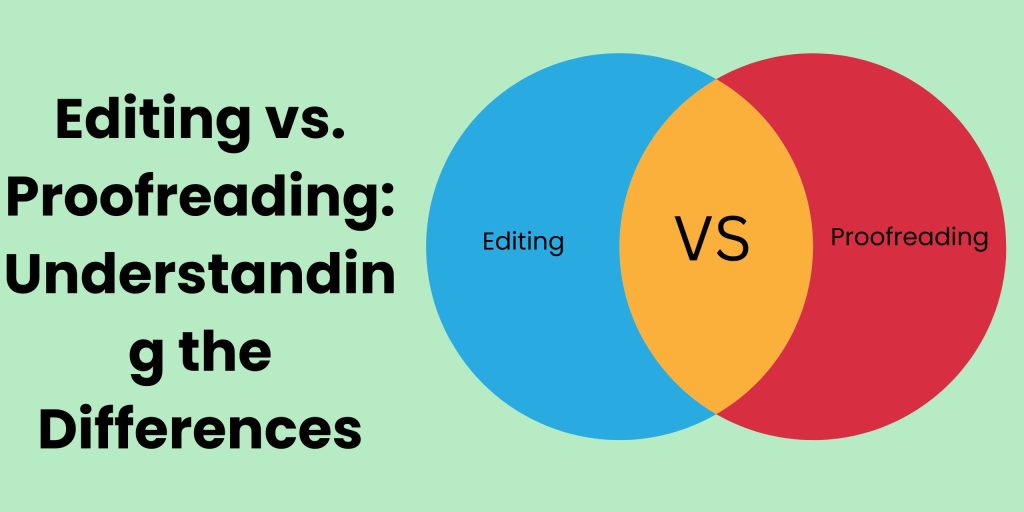Editing and proofreading are two distinct processes in the writing and publishing world, often performed at different stages to ensure the quality and accuracy of written content. While both are essential for producing polished and error-free work, it’s important to understand the differences between editing and proofreading. In this article, we will delve into the nuances of editing and proofreading, exploring their objectives, techniques, and when to employ each.
Editing: Shaping and Refining the Content
Editing is a comprehensive and in-depth process that focuses on improving the overall quality, clarity, and effectiveness of a written piece. The primary objective of editing is to refine the content, ensuring that it meets the intended purpose and resonates with the target audience. Editors work closely with the author to enhance the structure, organization, coherence, style, and flow of the writing. Here are some key aspects of the editing process:
- Content Evaluation: Editors evaluate the content for its relevance, coherence, and logical flow. They analyze the overall structure, identifying areas that require reorganization, additions, or deletions to improve the readability and comprehension of the text.
- Language and Style: Editors pay attention to the language used, ensuring consistency, clarity, and appropriateness for the intended audience. They refine sentence structures, eliminate wordiness, and enhance the overall writing style to make it more engaging and impactful.
- Fact-Checking and Accuracy: Editors verify the accuracy and reliability of the information presented in the content. They cross-check facts, figures, and references, ensuring that the content is supported by reliable sources and free from errors.
- Tone and Voice: Editors work to ensure that the tone and voice of the writing align with the intended purpose and the target audience. They may suggest adjustments to achieve the desired tone, whether it’s formal, informal, persuasive, or informative.
- Consistency and Formatting: Editors ensure consistency in grammar, punctuation, spelling, and formatting throughout the document. They adhere to specific style guides (such as APA, MLA, or Chicago Manual of Style) or organizational guidelines to maintain uniformity and professionalism.
- Feedback and Collaboration: Editors provide constructive feedback to the author, offering suggestions for improvement and addressing any concerns or questions that may arise during the editing process. This collaboration helps to refine the content and align it with the author’s vision.
Proofreading: Polishing and Perfecting the Details
Proofreading, on the other hand, focuses on the final stages of the writing process and is primarily concerned with identifying and correcting errors in grammar, punctuation, spelling, and formatting. The primary goal of proofreading is to ensure accuracy, consistency, and clarity in the written content. Here are key aspects of the proofreading process:
- Grammar and Punctuation: Proofreaders meticulously review the text to catch and correct errors in grammar, such as subject-verb agreement, verb tense consistency, and proper use of punctuation marks. They ensure that each sentence is grammatically correct and adheres to the rules of punctuation.
- Spelling and Typographical Errors: Proofreaders carefully scan the text for spelling errors, typos, and typographical mistakes. They correct misspelled words, homophone confusion, and typographical inconsistencies that may have been missed during the editing process.
- Formatting and Layout: Proofreaders check for consistency in formatting, ensuring that headings, subheadings, bullet points, numbering, and spacing are applied uniformly throughout the document. They also review the layout to ensure that it is visually appealing and aligned with industry standards or organizational requirements.
- Clarity and Coherence: Proofreaders pay attention to the overall clarity and coherence of the text. They ensure that sentences and paragraphs flow smoothly and that there are no awkward phrasing or ambiguous statements that could confuse the reader.
- Cross-Referencing and Checking References: Proofreaders verify that all citations, references, footnotes, and bibliographic entries are accurate and consistent. They cross-reference in-text citations with the reference list or bibliography, ensuring that the sources cited are correctly formatted and cited according to the required style guide.
- Final Checks: Proofreaders perform a final thorough check of the entire document, reviewing every detail to eliminate any lingering errors or inconsistencies. This includes a meticulous review of headings, subheadings, captions, tables, graphs, and any additional elements in the document.
When to Use Editing and Proofreading
Understanding when to employ editing and proofreading is crucial to ensure the effectiveness and efficiency of the writing process. Here are some scenarios where each process is most beneficial:
Editing:
- When the content requires substantial improvement in structure, organization, or overall clarity.
- When the focus is on refining the writing style, tone, and voice.
- When the document needs significant revisions or additions to enhance its effectiveness.
- When collaboration with the author is required to align the content with the intended purpose and audience.
Proofreading:
- After the editing process is complete, to catch any residual errors in grammar, spelling, punctuation, or formatting.
- Before publishing or submitting the final version of the document to ensure it is error-free and polished.
- For shorter pieces of writing, such as articles, blog posts, or emails, where the primary concern is accuracy and clarity rather than extensive content revisions.
In some cases, editing and proofreading may overlap, and the distinction between the two processes may blur. The specific requirements of each writing project and the desired outcome will determine the extent to which editing and proofreading are needed.
Conclusion
Editing and proofreading are complementary processes, each serving a unique purpose in the writing and publishing journey. Editing focuses on shaping and refining the content, ensuring clarity, coherence, and effectiveness. Proofreading, on the other hand, polishes and perfects the details, catching errors in grammar, spelling, punctuation, and formatting.
By understanding the differences between editing and proofreading, writers can approach their work more strategically, ensuring that it undergoes the appropriate level of scrutiny at each stage. Combining effective editing and meticulous proofreading leads to high-quality, error-free written content that effectively communicates the intended message to the target audience.
